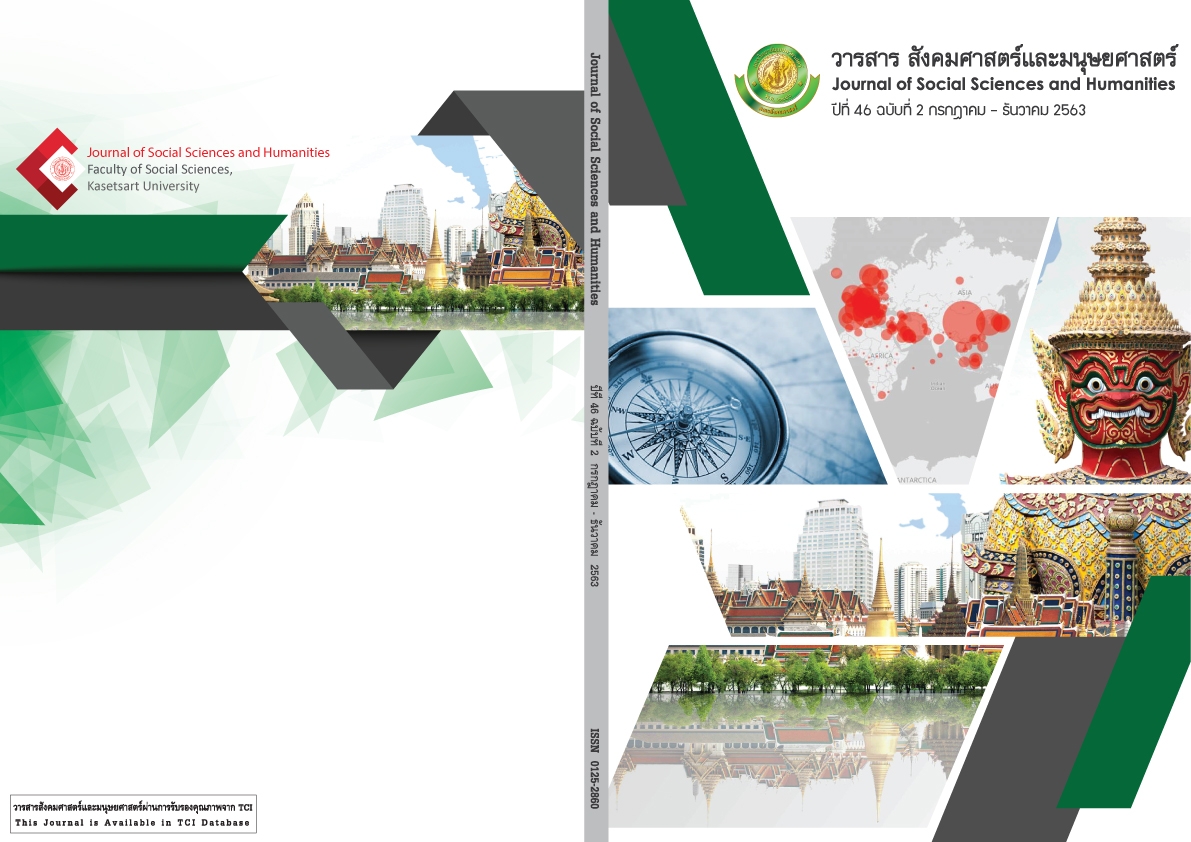การวิเคราะห์ผลิตภัณฑ์มวลรวมภายในประเทศต่อหัว ในกลุ่มประเทศที่มีรายได้สูง ปานกลางสูง และปานกลางต่ำ และผลกระทบของการนำนโยบายไปปฏิบัติ
Main Article Content
บทคัดย่อ
การวิจัยนี้มีวัตถุประสงค์ 1) เพื่อศึกษาเปรียบเทียบแนวโน้มการเจริญเติบโตผลิตภัณฑ์มวลรวมภายในประเทศต่อหัว (GDP) ในกลุ่มประเทศที่มีรายได้สูง ปานกลางสูง และปานกลางต่ำ และแสดงให้เห็นแนวโน้มการพัฒนา และ 2) เพื่อศึกษาผลกระทบนโยบายของการขับเคลื่อน GDP ต่อหัว และขีดความสามารถด้านเศรษฐกิจ โดยสุ่มตัวอย่างจาก 6 ประเทศ และเก็บข้อมูลย้อนหลัง 16 ปี ตั้งแต่ปี 2000 ถึง 2015 จำนวน 96 กลุ่มตัวอย่าง โดยผ่านการวิเคราะห์ข้อมูลแบบ Panel Data ใช้สถิติความถดถอยพหุ และแบบจำลองสมการโครงสร้าง ผลการเปรียบเทียบพบว่า ประเทศที่มี GDP ต่อหัวสูงสุดคือประเทศพม่า รองลงมาประเทศไทย ผลการวิเคราะห์ถดถอยพหุพบว่า ตัวแปรที่มีความสัมพันธ์ในทางบวกต่ออัตราการเจริญเติบโตของ GDP ต่อหัว ได้แก่ จำนวนประชากรทั้งหมด ประชากรหญิงที่มีอายุ 80 ปี อัตราการเจริญพันธุ์ของวัยรุ่น ประชากรที่มีอายุ 35-39 ปี พื้นที่ป่า และการเจริญเติบโตของประชากรเมือง และตัวแปรที่มีความสัมพันธ์ในทางลบต่อ GDP ต่อหัว ได้แก่ การเจริญเติบโตของประชากรชนบท และพื้นที่การเกษตร และผลการวิเคราะห์แบบจำลองสมการโครงสร้างพบว่า อัตราการเจริญพันธุ์ของวัยรุ่นและการเจริญเติบโตของประชากรเมือง มีความสัมพันธ์โดยตรงกับประชากรหญิงที่มีอายุ 80 ปี และพื้นที่ป่าและที่ดินการเกษตร และมีความสัมพันธ์โดยอ้อมต่อ GDP ต่อหัว แต่ความสัมพันธ์เป็นไปในทิศทางลบ ขณะที่อัตราการว่างงานและการเจริญเติบโตของประชากรชนบท มีความสัมพันธ์โดยตรงต่อประชากรหญิงที่มีอายุ 80 ปี พื้นที่ป่าและที่ดินการเกษตร และ GDP ต่อหัว และมีความสัมพันธ์โดยอ้อม นอกจากนี้ ประชากรหญิงที่มีอายุ 80 ปี พื้นที่ป่า และที่ดินการเกษตรมีความสัมพันธ์โดยตรงต่อ GDP ต่อหัว แต่ความสัมพันธ์นี้เป็นไปในทิศทางลบ
Article Details
เอกสารอ้างอิง
พลภัทร บุราคม. (2554). รายจ่ายสาธารณะ ประสิทธิภาพในการจัดสรรและประสบการณ์ระหว่างประเทศ (3 ed.). สมุทรปราการ: บรัษัท ดี.เค. ปริ้นติ้งเวิลด์ จำกัด.
Bucci, A., & Raurich, X. (2017). Population and Economic Growth under Different Growth Engines. German Economic Review, 18(2), 182-211.
Calkins, P. (2009). Sufficiency Economy Matrices: Multi-period Optimization for Local Development Planners. Journal of Economics and Management, 5(2), 305-332.
Choi, J., & Son, M. (2016). A Note on the Effects of Government Spending on Economic Growth in Korea. Journal of the Asia Pacific Economy, 21(4), 651-663.
Dao, M. Q. (2014). Female Labor Force Participation in Developing Countries. Economia Internazionale/International Economics, 67(3), 337-350.
Dudel, C., & Myrskyla, M. (2017). Working Life Expectancy at Age 50 in the United States and the Impact of the Great Recession. Demography, 54(6), 2101-2123.
Fagan, G., Gaspar, V., & McAdam, P. (2016). Immanuel Kant and Endogenous Growth Theory. Scottish Journal of Political Economy, 63(5), 427-442.
Farsio, F., & Quade, S. J. H. (2003). An empirical analysis of the relationship between GDP and unemployment. 19(3), 1-6.
Hajamini, M. (2015). The Non-linear Effect of Population Growth and Linear Effect of Age Structure on Per Capita Income: A Threshold Dynamic Panel Structural Model. Economic Analysis and Policy, 46, 43-58.
Hassan, A. F. M., Salim, R., & Bloch, H. (2011). Population Age Structure, Saving, Capital Flows and the Real Exchange Rate: A Survey of the Literature. Journal of Economic Surveys, 25(4), 708-736.
Kemp, R., & Never, B. (2017). Green Transition, Industrial Policy, and Economic Development. Oxford Review of Economic Policy, 33(1), 66-84.
Kurz, H. D. (1997). What Could the 'New' Growth Theory Teach Smith or Ricardo? Economic Issues, 2(2), 1-20.
Lin, Y.-H., & Chen, W.-Y. (2018). On the Relationship between Business Cycle and Fertility Rate in Taiwan: Evidence from the Nonlinear Cointegration Methodology. Romanian Journal of Economic Forecasting, 21(1), 140-156.
Ozerkek, Y., & Celik, S. (2010). The Link between Government Spending, Consumer Confidence and Consumption Expenditures in Emerging Market Countries. Panoeconomicus, 57(4), 471-485.
Saksiriruthai, S. (2017). Sufficiency Economy as the Concept for Value Chain Process Improvement: Evidence from Thailand. Actual Problems of Economics, 192(6), 93-100.
Salvati, L. (2018). Population Growth and the Economic Crisis: Understanding Latent Patterns of Change in Greece, 2002-2016. Letters in Spatial and Resource Sciences, 11(2), 105-126.
Siah, A. K. L., & Lee, G. H. Y. (2015). Female Labour Force Participation, Infant Mortality and Fertility in Malaysia. Journal of the Asia Pacific Economy, 20(4), 613-629.
Sommer, U. (2018). Women, Demography, and Politics: How Lower Fertility Rates Lead to Democracy. Demography, 55(2), 559-586.
Son, Y. J. (2018). Do Childbirth Grants Increase the Fertility Rate? Policy Impacts in South Korea. Review of Economics of the Household, 16(3), 713-735.
Whitaker, J. K. (2001). Henry George and Classical Growth Theory: A Significant Contribution to Modeling Scale Economies. American Journal of Economics and Sociology, 60(1), 11-24.
Zhang, W.-B. (2018). Economic Growth and Inequality with Tourism in an Integrated Walrasian-General Equilibrium and Neoclassical-Growth Theory. Zagreb International Review of Economics and Business, 21(1), 17-35.
Translated Thai References
Kamolpun Punpuing, & Suphaphan Katekum. (2017). Silver Economy and the Implication for Disability-Related Development Work in Thailand. Retrieved from http://www.rs.mahidol.ac.th/ncpd-2017/2017/Full-Paper/009.pdf
Ponlapat Buracom. (2011). Public Spending: Allocative Efficiency and International Experiences (3 ed.). Samutprakarn: D. K. Printing World Co., Ltd.


